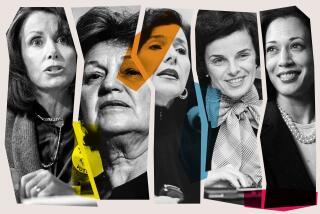Reflections From One Who Ran: No More the ‘Woman Candidate’ : Politics: Today’s female candidates have the experience and know-how to avoid campaign traps.
- Share via
NEW YORK — Dianne Feinstein will not be repeatedly asked if she knows enough and is experienced enough to run a government. She will not have to speculate endlessly on how her gender will play out among the voters. She will not face an incredulous press. She will not be constantly asked how it feels to run for a highly visible office.
Because women seeking such offices is no longer an unusual event. This year, 11 are running for their state’s governorship; seven want to be a U.S. senator.
In 1984, I was a third-term member of Congress from Queens when Walter F. Mondale chose me to be his running mate. I never doubted my capabilities to be vice president. But I really wasn’t prepared to deal with a national campaign, especially one of such historic interest.
I was not nationally known. I had no experience running for national office. I hadn’t even run for statewide office. My family was quite sheltered, partly because of our strong ethnic tradition of privacy, partly because the press and public had little interest in my husband and children. And the agenda of the persons who would be making the decisions about my life and my family’s was far broader than the future of Geraldine Ferraro.
Nor had running for Congress provided me with the kinds of experience that I could draw on in ’84. In 1978, I spent months preparing to leave the job of assistant district attorney to win one as a member of the House of Representatives. I hired a staff of five and set out to make a name for myself. My opponent, a right-wing member of the state Assembly, decided on a negative campaign early on.
He criticized me for having sent my children to private school. He coordinated the picketing of my home by Young Americans for Freedom, whose signs attacked my husband’s business. He kept anti-abortion activists informed of my appearances throughout the district.
We never got around to discussing the issues, but nobody noticed: The newspapers were on strike. When I won the election, the Queens edition of one of the papers that had just resumed publishing headlined its story: “Geraldine, Who?”
Feinstein and the other women candidates today are experienced politicians with long, well-known records of public service. Before they announced, I’m sure they spent months debating with family and friends the “what if’s” of every aspect of the planned campaign. And once in the race, they no doubt spent hours honing their positions on the issues, trying them out in public and refining them with the press. These women are in control.
They also share the advantage of having been exposed to the negative campaigning in the 1984 and 1988 presidential races. And they have learned from those experiences. As we saw in the Democratic primaries for governor in Texas and California, Ann Richards and Feinstein might be unwilling to initiate a negative attack. But once attacked, they will not hesitate to respond quickly and precisely.
Most important, however, the Feinsteins are not saddled with the designation “woman candidate.” They are candidates who happen to be women.
By this time next year, the press will be running stories about various governors and senators testing the waters for the 1992 presidential campaign. The question, of course, will be: Is it too soon for her to think about running?
When we have fewer women making history, we will have more women making policy.
More to Read
Get the L.A. Times Politics newsletter
Deeply reported insights into legislation, politics and policy from Sacramento, Washington and beyond. In your inbox twice per week.
You may occasionally receive promotional content from the Los Angeles Times.










